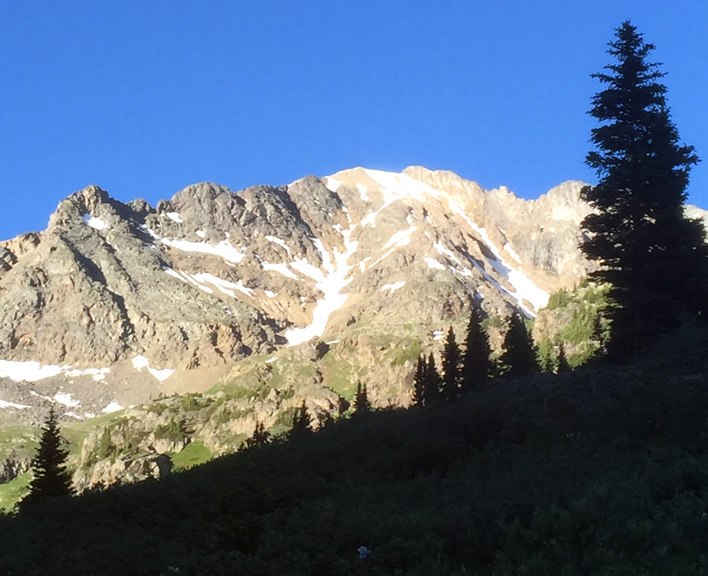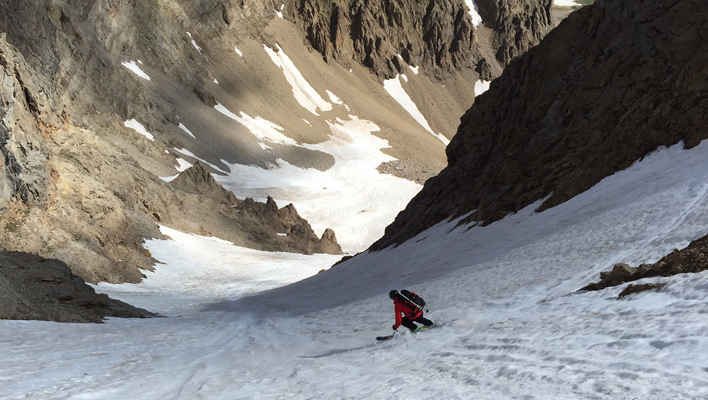By this point in the summer, photographs of steep South American couloirs and idyllic New Zealand peaks are probably filtering through your Instagram feed. With sweltering summer heat and the end of 4th of July festivities, you may have admitted defeat, tossed your skis into the closet and traded them in for your mountain bike. But rest assured—there’s still plenty of summer skiing to be had without spending your life savings on a plane ticket to the southern hemisphere—you just have to be willing to work for it.
Here’s the latest installment in An Skier’s Guide to Summertime Stoke. All summer long we’ll be sharing from our list of enough summer ski zones to keep you satisfied until the snow falls.
GRIZZLY PEAK, COLORADO: A CLASSIC COULOIR

Grizzly Peak, standing just shy of 14,000 feet, is a classic summer ski in the Colorado Rockies. [Photo] Courtesy Mike Marolt
SUMMIT ELEVATION: 13,988 ft.
MORE INFO: Grizzly Peak is accessible from Lincoln Creek off the east side of Independence Pass. The ascent is a four-mile hike to snow. Read about various routes off Grizzly Peak at summitpost.com.

Mike Marolt descends 2,000 vertical feet in Grizzly Couloir, an iconic line located right off Independence Pass near Aspen, Colo. [Photo] Courtesy Mike Marolt
If you are a summer skier and have an adventure or destination worth sharing, send your story and photos to intern@backcountrymagazine.com.










4 miles one way is too far. 2 miles is more realistic, especially with a fullpack and hiking in summer heat. If youre under 30 go for it, though.
Nonsense. Take advantage of every opportunity to ski in the mountains.
An important factor of skiing in summer is to know how the snow is. The snow starts turning into ice in July. It is best to know when the ice will have gotten enough sun to soften the snow surface. Cloud cover over night will typically keep the surface softer compared to a clear night sky. Warmer weather is better compared to a cooler temperature. In August, the ice gets even firmer. Some places it is possible to ski all months, especially after a big winter. The Mt Rainier area allows year round snow/ice.
You might get more than you can handle, especially when the ice becomes more prevalent, later in the summer. I went 2 miles and 1,200 ft for mid-aug turns in the sierra. But I’m in my mid 50’s.
HEY I AM 88 NOW I BEEN ALL OVER THE MOUNTAINS,MAINLY IN COLORADO IN MY LIST MY TOTAL OF ELEVATION IS,OR WAS 8 1/2 EVEREST, BUT FROM~2000 FETS, NOT FROM SEE LEVEL, NEVER ANY PROBLEM AND I ADVICE 2/3 DAY OF SUN AND 2/3 NIGHT OF FREEZING, AND BE ON THE TOP NOT BEFORE 10 A M = NO PROBLEM , EXEPT 1 AVALANCHE IN BERBIER IN THE BEGINNING TO FIND WHERE WAS THE TOP I JUST SPIT AND GO OPPOSITE OF IT. ,NOW I AM DONE AND JUST LEARN TO GO DOWN THE GROUND A LATE THEN I CAN. ,BE SAFE,STAY YOUNG/ AND IN CONTROL. LIFE IS GOOD . GOOD LUCK. HA I NEVER USE A BACON, ONLY 1 AVALANCHE CORD, SOME TIME WHIT A BALOON IF I WAS NOT ALONE JUST FOLLOW THE CORDE TO FIND ME . GOOD LUCK ALL, BE SAFE , AND WAIT FOR THE SPRING TO GO IN BACK COUNTRY. NO PROBLEM, FOR MORE INFO GO TO YOU TUBE “THE FRENCHY ” AMEN.
just did above no ??